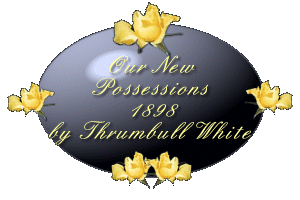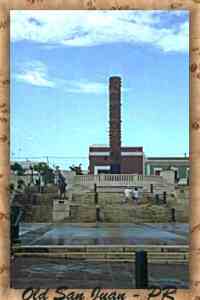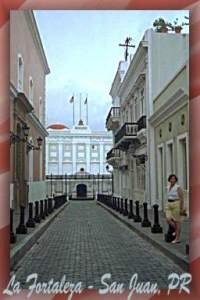
|
For history pages 2, 3, 4 , 5 , and 6

PUERTO RICO IN HISTORY

 he history of Puerto Rico is exceedingly short, measured by the events that have happened of sufficient consequence to record. Although it was discovered by Christopher Columbus upon his second voyage in 1493, yet so comparatively even and unbroken has been its career since that time, that it will not require many pages to relate the things usually classified as history. The Philippines have been the scene of constant warfare between the Spanish and the Moros. Cuba has every page of its history blotted by the dark deeds of the Spanish conquerors, resulting in insurrection after insurrection. Even our little island possession of Hawaii has a career more dramatic than that of Puerto Rico. A great writer has said that that country, like that family, is happiest which has the least history. Wars are not to be envied, even though they are interesting. Puerto Rico has been enabled by the continuance of peace most of the time throughout the last few centuries, to develop her industries and multiply her prosperity as she could not have done under different conditions. With the handicap of Spanish government to overcome, this island, the fourth in size of the Greater Antilles, is to be congratulated for the degree of comfort attained.
he history of Puerto Rico is exceedingly short, measured by the events that have happened of sufficient consequence to record. Although it was discovered by Christopher Columbus upon his second voyage in 1493, yet so comparatively even and unbroken has been its career since that time, that it will not require many pages to relate the things usually classified as history. The Philippines have been the scene of constant warfare between the Spanish and the Moros. Cuba has every page of its history blotted by the dark deeds of the Spanish conquerors, resulting in insurrection after insurrection. Even our little island possession of Hawaii has a career more dramatic than that of Puerto Rico. A great writer has said that that country, like that family, is happiest which has the least history. Wars are not to be envied, even though they are interesting. Puerto Rico has been enabled by the continuance of peace most of the time throughout the last few centuries, to develop her industries and multiply her prosperity as she could not have done under different conditions. With the handicap of Spanish government to overcome, this island, the fourth in size of the Greater Antilles, is to be congratulated for the degree of comfort attained.
AMERICAN IMPRESSIONS OF THE SPANISH
The Spanish were not the only soldiers who had had an impressive lesson on that journey across Puerto Rico. If they had learned the size and excellent equipment of American soldiers, the Americans, too, had learned more respect for their Spanish enemy. The force kept in Puerto Rico by Spain was a selected army, of the highest type of soldiers that the peninsula could furnish. It was well equipped and well nurtured. There was no such hardship and poverty to be undergone as that which had enfeebled the Spanish army in Cuba. They were soldiers in the genuine military sense of the word and quite able and willing to make a fight for their country.

It is true that Spanish garrisons along the south coast of the island fell back after the landing of the American army of invasion without very strenuous opposition. But the conditions were perfectly obvious to one who studied the matter. The garrisons at Guánica, Ponce and Guayama were detached bodies, remote from their supports and facing an overwhelming landing force. When, however, they withdrew to their works in the mountains the condition became very different. The Spanish army in Puerto Rico, intrenched as it was in the mountains between Aibonito and Cayey and between Guayama and Cayey, would have offered a resistance to an American advance which could not have been overcome without an enormous loss of life and desperate fighting.
Those mountain defiles were so fortified as to be almost impregnable. From cliffs and hills above, artillery and machine guns, as well as rifles, could sweep the road over which an advancing force must pass, with a fire that would be simply intolerable. At the same time the men at the guns would be absolutely concealed and exempt from even a threat of danger in many instances.
Page 351

The system of rifle-pits and earthworks of all sorts guarding the military road through this range of mountains was so perfect as to compel the admiration of the American soldiers and officers who caught but a bare glimpse of it. It was frankly admitted to me by officers of General Brooke's staff who studied the situation that the difficulties of an advance across the island by this road would have been terrific. The campaign as far as it was carried was simple and easy. We have reason to be thankful that peace intervene before it became necessary to force a passage into Aibonito and Cayey.
If the American advance had successfully passed the fortifications in the mountains, there would have been no other obstacles of great consequence until the city of San Juan itself was approached. Then, however, unless an American fleet had reduced the city by bombardment and made its fortifications untenable, the Americans would have met a resistance exceedingly difficult to overcome. In another chapter I shall describe the defenses of this perfect example of an ancient walled city in more detail. Here it is to be said only that the city is on an island with but one approach available for forces advancing by land. The rifle-pits and fortresses guarding the bridges are of the most perfect character and would form an obstacle, when well manned, almost insurmountable for infantry and cavalry. It is a question even if sufficient artillery could have been brought across the island to make an adequate assault on the city's defenses to the east. Here again, then there must have been great loss of life before the city could be taken.
PAGE 365
The total population of the island of Puerto Rico is, perhaps, 900,000, although there is no census sufficiently accurate to afford definite figures. The island is known as "the whitest of the Antilles" because the negro population is less dominant there than in any other of the West Indies. Probably 150,000 of the inhabitants are peninsulares, as the natives of Spain are termed throughout the colony. From 12,000 to 14,000 are foreigners, mostly Frenchmen, Germans, Italians and Englishmen. The native population is composed of about two-thirds whites, who are descendants of Spaniards, and one-third negroes, and those of mixed blood or half-castes. Many of the blacks come from Barbadoes, Jamaica, St. Thomas and the other Antilles. It is evident that the density of population of the island is great, the nearest estimates calculating about 250 per square mile. This far outranks the population of Cuba, for the latter island, although some thirteen times as large as Puerto Rico, contains not nearly twice as large a population. This fact must be kept in mind in calculating the possibilities of the commercial and agricultural development of the country.


 |


The links on this banner are not necessarily endorsed by Ivelisse Hernández |
| ||
The links on this banner are not necessarily endorsed by Ivelisse Hernández |